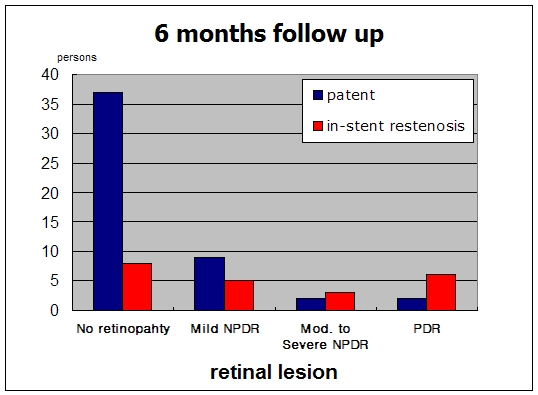| №ЯЗҘЗьҪД : ЖчҪәЕН
|
Бўјц№шИЈ - 480450 40 |
| The Grade of Diabetic Retinopathy Have a Powerful Predictive Relevance of In-Stent Restenosis After Percutaneous Coronary Intervention |
| м„ңмҡёлҢҖн•ҷкөҗмқҳкіјлҢҖн•ҷ лӮҙкіјн•ҷкөҗмӢӨ 1), м„ңмҡёлҢҖн•ҷкөҗлі‘мӣҗ мӢ¬нҳҲкҙҖм„јн„° 2) |
| н•ңм •к·ң1)2), к№Җм„ұнҷҳ1)2),кө¬ліёк¶Ң1)2),к№ҖнҡЁмҲҳ1)2),мҶҗлҢҖмӣҗ1)2),мҳӨлі‘нқ¬1)2),мқҙлӘ…л¬ө1)2),л°•мҳҒл°°1)2),мөңмңӨмӢқ1)2) |
Introduction: The grade of diabetic retinopathy is affected by the duration and severity of diabetes that has been identified as a predictor of in-stent restenosis (ISR). We examined the association between a grade of diabetic retinopathy and the incidence of ISR after percutaneous coronary intervention (PCI) in diabetic patients.
Methods: Of the 102 diabetic patients who underwent elective bare metal stent implantation, we identified 72 subjects whose retinae were evaluated within 6 month prior to PCI. A grading of retinopathy was performed by trained and certificated ophthalmologists. Follow-up angiography was performed at six months after the index intervention. We used multiple logistic regression to estimate the odds ratio (OR) for ISR associated with diabetic retinopathy
Results: The presence of diabetic retinopathy increased the risk of restenosis (OR 9.1). The restenosis incidence was higher as severity of diabetic retinopathy (see a graph). After controlling blood pressure, glycosylated hemoglobin, lipid, stent length and diameter, the grade of diabetic retinopathy was found to be an independent predictor of ISR with OR of 10.3 for mild to moderate non-proliferative retinopathy, 18.9 (95% CI, 2.6 to 137.8) for proliferative retinopathy.
Conclusions: The grade of diabetic retinopathy independently correlates with ISR incidence especially for proliferative retinopathy. It is suggested that a grade of diabetic retinopathy is a useful predictor of ISR which is necessary to decide on management of patients with coronary artery disease.
|
|
|
Warning: getimagesize(/home/virtual/circulationadmin/htdocs/econgress/conference/abstract/img_files/ISR.jpg) [function.getimagesize]: failed to open stream: No such file or directory in /home/virtual/circulationadmin/new/econgress/conference/manage/schedule/view_abstract.php on line 164

|
|




